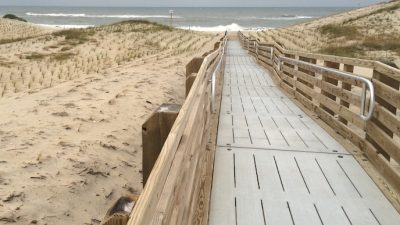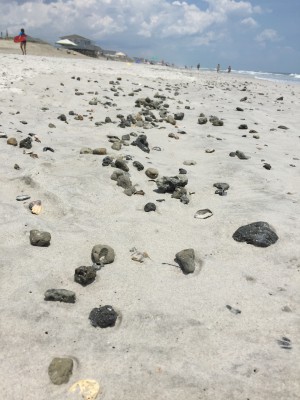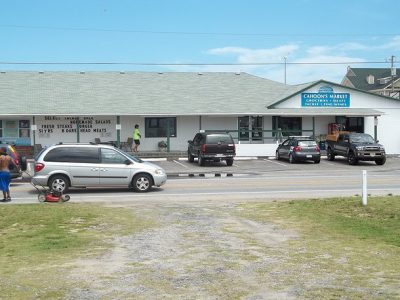MANTEO – Sand is a commodity in one place, and a nuisance in another. Sometimes all it takes is a bit of bulldozing or a battering coastal wind to turn one into the other. With sand management an increasingly urgent need, coastal regulators in North Carolina are frequently confronted with that dichotomy.
At a recent meeting here of the state Coastal Resources Commission, which sets policy for the state’s coastal management program, members first listened to a presentation about amending the rules on getting compatible sand to widen beaches. A little bit later in the morning, they listened to a presentation about amending the rules on getting rid of sand clogging pools and blocking driveways.
Supporter Spotlight

“I think our rules need updating, quite frankly,” Renee Cahoon, the chair of the Coastal Resources Commission, said at the April 26-27 meeting, her first at the helm since former chair Frank Gorham stepped down in March. “We need to modernize some of our rules.”
Cahoon was responding to a sweeping overview of the evolution of dunes, beach accesses and removal of wayward sand provided by Frank Jennings, state Division of Coastal Management district manager in Elizabeth City. Starting with a photograph of a completely flat expanse of Outer Banks beach taken in the 1920s, Jennings showed how dune systems gradually started lining the oceanfront before World War II and, stabilized with grasses, later became essential to protect infrastructure from the surf.
But sand has proved to be an unruly subject, as often consuming as buffering buildings. Even when the beach was widened in Nags Head, Jennings said, property may have been protected from the ocean, but the sand engulfed houses, pools, walkways, beach accesses, yards, decks and driveways. Out-of-town owners would come back in the spring and see sand completely filling the area between the pilings under their house.
Coastal rules do not allow sand to be moved back to the beach, he said, which makes it difficult for homeowners to get rid of it. In Nags Head, the division had to modify the town’s permit so the town could administer moving sand back to the beach system.
Access for all to the beach is also problematic. Although so-called “Hatteras ramps” – wooden paths over the dunes – are permitted, Jennings said, they do not go far enough to allow wheel chairs and strollers to get beyond the beach edge. Mats that can be rolled out and driven over would be more practical, but they are not currently allowed.
Supporter Spotlight

“We have a conflict when permitting beach accesses,” Jennings told the panel, adding that the dune rules have changed little since they were first written in 1981.
Rules need to respond to the realities of conditions and alignment of beaches in different locations, he said. He suggested it would help if people were allowed to place fill on the front side of dunes, use mats to get on a beach and put storm-driven sand back on the beach.
Jennings was asked to consult with the Coastal Resources Advisory Council to find solutions. The council is a 20-member group that provides the CRC with local government perspectives and advice.
Meanwhile, division staff is working on amending sediment criteria rules that ensures compatible sand is used in beach re-nourishment projects.
The proposed amendment would allow project engineers and consultants to design sampling protocol to characterize native beach and the compatibility of borrow site sand. It would not change existing standards for grain sizes.
After a brief presentation from Ken Richardson, the division’s shoreline management specialist, the panel asked that he consult with stakeholders and return with a final version of the rule at the CRC’s July meeting in Greenville.
“The bottom line is performance – that what ends up on the beach is compatible,” Braxton Davis, division director, told commissioners. “If it’s not, we can shut the project down.”

In a later telephone interview, Richardson said the proposed amendment could provide more flexibility to project engineers, and potentially make projects less costly. It could also speed up the permitting process and the response to erosion hot spots.
But he said it would not necessarily prevent a repeat of what happened at North Topsail Beach, where the beach material pumped in for re-nourishment ended up having a large number of rocks. That situation, he said, was not anyone’s fault.
“It was one of those things that you just don’t know until it gets on the beach,” Richardson said.
“There may be instances where less sampling is needed, and there may be times when more sampling is needed,” he added. “The main goal is to ensure at the end of the project, the sand that was placed there matches the sand that was there before.”
The proposed amended rule would not change access to sensitive sand borrow areas. It would, however, provide more clarification on required compatibility standards of beach material.
“We’re trying to make things a little easier in allowing experts doing their work to use their expertise,” Richardson said.
In other action, the CRC:
- Approved a variance request by the Sanitary Fish Market & Restaurant in Morehead City, allowing construction of stairs to the roof top
- Approved a new beachfront development line on Figure Eight Island
- Selected Commissioner Neal Andrew as CRC vice-chair and Commissioner Greg Lewis as second vice-chair.
Cahoon Brings Firsthand Experience
The 13-member commission is the rule-making body for the Coastal Area Management Act. It is also charged with identifying areas of environmental concern.
Although Cahoon has been a member of the CRC since 2002, and served as vice-chair for four years, it seems fitting that she first occupied the seat as chair while meeting on her sliver of coast.
A Hyde County native, Cahoon, 61, runs her family’s vintage grocery store and cottage court on the oceanfront in Nags Head, dealing firsthand with wind, water and sand coming and going.

By dint of her decades of serving in numerous public offices – Nags Head mayor, Dare County Board of Commissioners, chair of the Dare County Tourism Board and, currently, the Nags Head Board of Commissioners – Cahoon is close to the ground on evolving coastal needs and concerns of the public. And she is a seasoned observer of what makes a panel of disparate public servants effective.
“I think we have a good commission overall,” Cahoon said in a later interview at her small office at the back of Cahoon’s Market. “I don’t think anybody wants to deprive anyone of their property rights. As with everything, there’s a tendency to go too far to the right and too far to the left, and I think this commission is a common-sense commission.”
Gov. Roy Cooper appointed Cahoon to chair the CRC on March 15. She is to serve for two years, after which she would need to be reappointed. Gorham, a New Hanover County businessman from Figure Eight Island, had submitted his resignation a week earlier, after serving as chair since 2013.

Gorham was “an excellent chairman,” Cahoon said. “I hope I am as inclusive as he was. I hope to be as consensus-driven as he was and respecting different points of view.”
Compared with him, Cahoon said, she may be more “process-oriented.” But she sidestepped a direct answer about her view on staff recommendations, which at times didn’t seem to impress Gorham.
“I respect the process of how things are done and I think staff will have great input,” she said. “I think we will follow the due process and try not to be distracted by any other interested parties.”
Cahoon said she supports the 30-year sea-level rise report with rolling five-year updates as approved under Gorham’s watch, saying it is “more understandable” than the earlier, more controversial, 100-year plan. She added that “she would love it” if East Carolina University geologist Stan Riggs would re-join the CRC Science Panel. Riggs, an original member of the advisory panel, quit last July to protest what he characterized as political pressure over sea-level science.
She also said she sees Gorham’s point about the management term “inlet hazard area” sounding scary – a comment he made last summer that was met with some criticism – but she agreed that the term does serve a descriptive purpose.
“I also think it’s a warning,” she said. “I think people need to be aware that there is some danger building on inlets. I think our job is to give people the best information.”
Overall, Cahoon said, she seeks to find the sweet spot between public trust protections and private property rights.
“My goal as commission chair is to figure out what’s best for the state of North Carolina, while protecting the economy behind it,” Cahoon said. “It’s a balancing act.”








